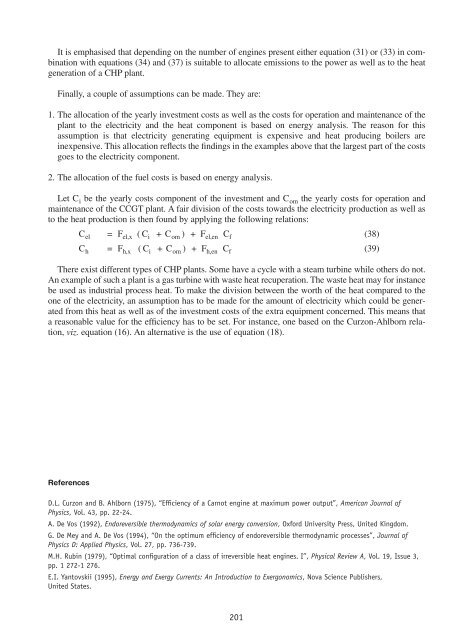Projected Costs of Generating Electricity - OECD Nuclear Energy ...
Projected Costs of Generating Electricity - OECD Nuclear Energy ...
Projected Costs of Generating Electricity - OECD Nuclear Energy ...
Create successful ePaper yourself
Turn your PDF publications into a flip-book with our unique Google optimized e-Paper software.
It is emphasised that depending on the number <strong>of</strong> engines present either equation (31) or (33) in combination<br />
with equations (34) and (37) is suitable to allocate emissions to the power as well as to the heat<br />
generation <strong>of</strong> a CHP plant.<br />
Finally, a couple <strong>of</strong> assumptions can be made. They are:<br />
1. The allocation <strong>of</strong> the yearly investment costs as well as the costs for operation and maintenance <strong>of</strong> the<br />
plant to the electricity and the heat component is based on energy analysis. The reason for this<br />
assumption is that electricity generating equipment is expensive and heat producing boilers are<br />
inexpensive. This allocation reflects the findings in the examples above that the largest part <strong>of</strong> the costs<br />
goes to the electricity component.<br />
2. The allocation <strong>of</strong> the fuel costs is based on energy analysis.<br />
Let C i be the yearly costs component <strong>of</strong> the investment and C om the yearly costs for operation and<br />
maintenance <strong>of</strong> the CCGT plant. A fair division <strong>of</strong> the costs towards the electricity production as well as<br />
to the heat production is then found by applying the following relations:<br />
C el = F el,x (C i +C om ) + F el,en C f (38)<br />
C h = F h,x (C i +C om ) + F h,en C f (39)<br />
There exist different types <strong>of</strong> CHP plants. Some have a cycle with a steam turbine while others do not.<br />
An example <strong>of</strong> such a plant is a gas turbine with waste heat recuperation. The waste heat may for instance<br />
be used as industrial process heat. To make the division between the worth <strong>of</strong> the heat compared to the<br />
one <strong>of</strong> the electricity, an assumption has to be made for the amount <strong>of</strong> electricity which could be generated<br />
from this heat as well as <strong>of</strong> the investment costs <strong>of</strong> the extra equipment concerned. This means that<br />
a reasonable value for the efficiency has to be set. For instance, one based on the Curzon-Ahlborn relation,<br />
viz. equation (16). An alternative is the use <strong>of</strong> equation (18).<br />
References<br />
D.L. Curzon and B. Ahlborn (1975), “Efficiency <strong>of</strong> a Carnot engine at maximum power output”, American Journal <strong>of</strong><br />
Physics, Vol. 43, pp. 22-24.<br />
A. De Vos (1992), Endoreversible thermodynamics <strong>of</strong> solar energy conversion, Oxford University Press, United Kingdom.<br />
G. De Mey and A. De Vos (1994), “On the optimum efficiency <strong>of</strong> endoreversible thermodynamic processes”, Journal <strong>of</strong><br />
Physics D: Applied Physics, Vol. 27, pp. 736-739.<br />
M.H. Rubin (1979), “Optimal configuration <strong>of</strong> a class <strong>of</strong> irreversible heat engines. I”, Physical Review A, Vol. 19, Issue 3,<br />
pp. 1 272-1 276.<br />
E.I. Yantovskii (1995), <strong>Energy</strong> and Exergy Currents: An Introduction to Exergonomics, Nova Science Publishers,<br />
United States.<br />
201

















